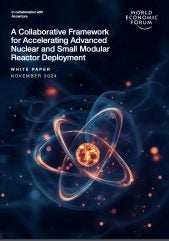
The World Economic Forum (WEF) has released a new report, A Collaborative Framework for Accelerating Advanced Nuclear and Small Modular Reactor Deployment, noting that now is the time to deploy and scale-up advanced nuclear and small modular reactors (SMRs).
The 25-page report says SMRs and other advanced nuclear technologies “represent clean energy solutions that, when built at scale, could deliver cost-effective carbon-free energy”. These technologies “are well suited to meet many clean power and heat use cases for heavy industry, data centres and transport”. According to WEF, “Collaboration across the nuclear ecosystem is vital to improve the economics and bankability of new-builds through cost-competitive deployment models and timely project delivery.” In addition, public-private partnerships “must develop enabling policies, drive modernisation of regulations, and build a supply chain and workforce to deliver advanced nuclear and SMRs at scale”.
WEF says it partnered with stakeholders across the nuclear ecosystem to develop the framework as “a tool that can align stakeholders on key actions and strategies within nine priority areas to accelerate deployment”. The stakeholders include “experts from large energy consuming industries, financiers, reactor vendors, supply chain businesses, utilities, government organisations, non-profits/NGOs and academia”.
The nine priority areas are: 1 Signalling and meeting demand; 2 Evolving energy policy; 3 Modernising regulation; 4 Transforming project deployment; 5 Repurposing and clustering infrastructure; 6 Maturing advanced energy technology; 7 Building supply chain readiness; 8 Developing talent; and 9 Catalysing investment.
Public-private partnerships “are crucial for developing enabling policies, driving modernisation of regulations and building a supply chain to deliver advanced nuclear and SMRs at scale”. The Framework “provides a basis for locally led implementation, as priorities will vary across geographies at various stages of nuclear development”.
As an example of priority 1 – Signalling and meeting demand – WEF presents a case study on Great British Nuclear (GBN). “Working with industry, GBN aims to accelerate technology development, mobilise supply chains and reduce early-stage risks to achieve the UK’s energy independence and net-zero ambitions.”
As to Priority area 2 – Evolving energy policy – WEF says countries must collaborate to address barriers to cooperation. It points to the US Advanced Reactor Demonstration Program (ARDP); the establishment by Poland and 18 other European countries of a working group to support commercialisation of GE Hitachi’s BWRX-300 reactor; and the call to action by the European Union (EU) in its 2024 manifesto.
Priority area 4 – Transforming project deployment – cites examples of innovative approaches to project delivery including: applying digital tools for accurate, performance-based project budget and timeline estimates and project management; maintaining a data model and standardised design documentation throughout construction; digitising plant design and construction processes; adopting modern methods of construction; utilising open architecture by collaborating to agree on a common but customisable modular architecture with standardised interfaces; and evaluating contracting models with EPCs and developers to sharing risks.
With respect to Priority area 6 – Maturing advanced energy technology – WEF says the first projects built will pave the way for standardisation of components and production methods. “For example, China Huaneng Group’s HTR-PM plant features more than 2,200 sets of first-of-a-kind equipment. The supporting fuel element production line has the largest production capacity in the world.”
Priority area 7 – Building supply chain readiness – notes that geopolitical conflicts highlight the need for resilient domestic supply chains to enhance energy security. This requires investment in mining, enrichment, manufacturing and fuel efficiency for future reactors. Advancements in high-assay low enriched uranium (HALEU) and mixed oxide (MOX) fuel are crucial, but are currently underproduced. “Government investment is critical to scale-up the nuclear supply chain to support robust new-build programmes, but early investments carry risk. Localised demand signals with off-take agreements can de-risk investment by clarifying timelines to achieve critical mass.”
Priority area 9 – Catalysing investment – looks to green bonds and loans, coupled with guarantees, as some of the financing mechanisms that can serve as tools for facilitating risk mitigation and broader investor participation. Past lessons emphasise “the value of government-backed programmes that provide guardrails or insurance mechanisms”. Export guarantees, provided by export credit agencies, can help increase banking liquidity to finance projects. “Grants and tax incentives similar to those that have advanced renewable technology and deployment can also support nuclear”. Governments and multilateral organisations can reduce risk by including nuclear in clean energy and decarbonisation taxonomies.
As a case study, WEF suggests creating a new multilateral financial institution for nuclear. “The International Bank for Nuclear Infrastructure (IBNI) is a conceptual new multilateral IFI aimed at supporting embarking countries and nuclear-exporting countries in accelerating the development and rapid expansion of nuclear energy capacities through financing and other support. IBNI seeks to enable nuclear technologies to rapidly de-risk, scale-up and improve cost curves. IBNI would offer ‘stapled financing’ and other support tools that qualified suppliers and developers could offer their customers.”
Examples of proposed IBNI financing and support tools include: emerging technologies supplemental grant and concessionary financing; committed equity financing of projects and companies through supply chains; committed senior and/or subordinate debt financing; hedging contracts with respect to interest rates, inflation, and currency risks; completion risk insurance and committed contingent debt and/or equity financing; and commercial guarantees and sovereign risk guarantees.
In conclusion, WEF says countries can apply the Framework to deploy advanced nuclear and SMRs in ways tailored to local contexts and pathways. “This Framework, developed with nuclear ecosystem stakeholders, serves as a multistake-holder tool to drive the systemic change needed for new nuclear development. While countries with established nuclear programmes and those embarking on nuclear development will have different approaches, the Framework can be tailored to specific contexts and implementation pathways.”






